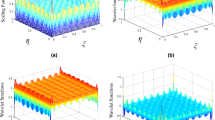Abstract
By interacting and synchronizing wavelet theory in mathematics and variational principle in finite element method, a class of wavelet-based plate element is constructed. In the construction of wavelet-based plate element, the element displacement field represented by the coefficients of wavelet expansions in wavelet space is transformed into the physical degree of freedoms in finite element space via the corresponding two-dimensional C1 type transformation matrix. Then, based on the associated generalized function of potential energy of thin plate bending and vibration problems, the scaling functions of B-spline wavelet on the interval (BSWI) at different scale are employed directly to form the multi-scale finite element approximation basis so as to construct BSWI plate element via variational principle. BSWI plate element combines the accuracy of B-spline functions approximation and various wavelet-based elements for structural analysis. Some static and dynamic numerical examples are studied to demonstrate the performances of the present element.
Similar content being viewed by others
References
Cohen A (2003). Numerical analysis of wavelet method. Elsevier, Amsterdam
Dahmen W (2001). Wavelet methods for PDEs—some recent developments. J Comput Appl Math 128: 133–185
Canuto C, Tabacco A and Urban K (1999). The wavelet element method part I: construction and analysis. Appl Comput Harmon A 6: 1–52
Canuto C, Tabacco A and Urban K (2000). wavelet element method part II: realization and additional feature in 2D and 3D. Appl Comput Harmon A 8: 123–165
Li S and Liu WK (1998). Synchronized reproducing kernel interpolant via multiple wavelet expansion. Comput Mech 21: 28–47
Chen XF, Yang SJ and He ZJ et al (2004). The construction of wavelet finite element and its application. Finite Elem Anal Des 40: 541–554
Chen WH and Wu CW (1996). Extension of spline wavelets element method to membrane vibration analysis. Comput Mech 18: 46–54
Han JG, Ren WX and Huang Y (2005). A multivariable wavelet-based finite element method and its application to thick plates. Finite Elem Anal Des 41: 821–833
Han JG, Ren WX and Huang Y (2006). A spline wavelet finite element method in structural mechanics. Int J Num Meth Eng 66: 166–190
Xiang JW, Chen XF, He ZJ, Dong HB (2006) The construction of 1D wavelet finite elements for structural analysis. Comput Mech doi:10.1007/s00466-006-0102-5:1-15
Xiang JW, Chen XF, He YM and He ZJ (2006). The Construction of plane elastomechanics and Mindlin plate elements of B-spline wavelet on the interval. Finite Elem Anal Des 42: 1269–1280
Xiang JW, He ZJ and Chen XF (2006). The construction of wavelet-based truncated conical shell element using B-spline wavelet on the interval. Acta Mech Solida Sin 19(4): 316–326
Xiang JW, Chen XF, He YM and He ZJ (2007). Static and vibration analysis of thin plates by using finite element method of B-spline wavelet on the interval. Struct Eng Mech 25(5): 613–629
Amaratunga K and Sudarshan R (2006). Multiresolution modeling with operator-customized wavelets derived from finite elements. Comput Meth Appl Mech Eng 195: 2509–2532
Sudarshan R, Amaratunga K and Gratsch T (2006). A combined approach for goal-oriented error estimation and adaptivity using operator-customized finite element wavelets. Int J Num Meth Eng 66: 1002–1035
Bertoluzza S, Naldi G and Ravel JC (1994). Wavelet methods for the numerical solution of boundary value problems on the interval. In: Chui, CK, Montefusco, L, and Puccio, L (eds) Wavelets: theory, algorithms, and applications, pp 425–448. Academic, London
Chui CK and Quak E (1992). Wavelets on a bounded interval. Numer Math Approx Theory 1: 53–57
Quak E and Weyrich N (1994). Decomposition and reconstruction algorithms for spline wavelets on a Bounded interval. Appl Comput Harmon A 1: 217–231
Goswami JC, Chan AK and Chui CK (1995). On solving first-kind integral equations using wavelets on a bounded interval. IEEE T Antenn Propag 43: 614–622
Mallat SG (1999). A wavelet tour of signal processing. Academic, London
Wang XC (2002). The finite element methods. Tsing Hua University Press, Beijing (in Chinese)
Morley LSD (1963). Skew plates and structures. Pergamon, Oxford
Zienkiewicz OC and Lefebvre D (1988). A robust triangular plate bending element of the Reissner–Mindlin type. Int J Num Meth Eng 26: 1169–1184
Hinton E and Huang HC (1986). A family of quadrilateral Mindlin plate elements with substitute shear strain fields. Comput Struct 23: 409–431
Zienkiewicz OC, Taylor RL and Too JM (1971). Reduced integration technique in general analysis of plates and shells. Int J Num Meth Eng 3: 275–290
Malkus DS and Hughes JR (1978). Mixed finite element methods reduced and selective integration techniques: a unification of concepts. Comput Meth Appl Mech Eng 15: 63–81
Batoz JL and Tahar MB (1982). Evaluation of a new quadrilateral thin plate bending element. Int J Num Meth Eng 18: 1655–1677
Brezzi F, Bathe KJ and Fortin M (1989). Mixed interpolated element based on Mindlin/Reissner plate theory and mixed interpolation. Int J Num Meth Eng 28: 1787–1801
Chen WJ and Chueng YK (2000). Refined quadrilateral element based on Reissner/Mindlin plate theory. Int J Num Meth Eng 47: 605–627
Raju KK and Hinton E (1980). Natural frequencies and modes of rhombic Mindlin plates. Earthq En Struct Dyn 8: 55–62
Liew KM, Xiang Y, Kittipornchai S and Wang CM (1993). Vibration of thick skew plates based on Mindlin shear deformation plate theory. J Sound Vib 168: 39–69
Liu WK, Han WM, Lu HS, Li SF and Cao J (2004). Reproducing kernel element method Part I: theoretical formulation. Comput Meth Appl Mech Eng 193: 933–951
Weissman SL and Taylor RL (1990). Resultant fields for mixed plate bending elements. Comput Meth Appl Mech Eng 79: 321–355
Author information
Authors and Affiliations
Corresponding author
Rights and permissions
About this article
Cite this article
Jiawei, X., Xuefeng, C., Zhengjia, H. et al. A new wavelet-based thin plate element using B-spline wavelet on the interval. Comput Mech 41, 243–255 (2008). https://doi.org/10.1007/s00466-007-0182-x
Received:
Accepted:
Published:
Issue Date:
DOI: https://doi.org/10.1007/s00466-007-0182-x



